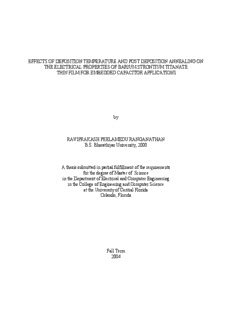
EFFECTS OF DEPOSITION TEMPERATURE AND POST DEPOSITION ANNEALING ON THE ... PDF
Preview EFFECTS OF DEPOSITION TEMPERATURE AND POST DEPOSITION ANNEALING ON THE ...
UUnniivveerrssiittyy ooff CCeennttrraall FFlloorriiddaa SSTTAARRSS Electronic Theses and Dissertations, 2004-2019 2004 EEffffeeccttss OOff DDeeppoossiittiioonn TTeemmppeerraattuurree AAnndd PPoosstt DDeeppoossiittiioonn AAnnnneeaalliinngg OOnn TThhee EElleeccttrriiccaall PPrrooppeerrttiieess OOff BBaarriiuumm SSttrroonnttiiuumm TTiittaannaattee TThhiinn FFiillmm FFoorr EEmmbbeeddddeedd CCaappaacciittoorr AApppplliiccaattiioonnss Ranganathan, Ravip Peelamedu University of Central Florida Part of the Electrical and Electronics Commons Find similar works at: https://stars.library.ucf.edu/etd University of Central Florida Libraries http://library.ucf.edu This Masters Thesis (Open Access) is brought to you for free and open access by STARS. It has been accepted for inclusion in Electronic Theses and Dissertations, 2004-2019 by an authorized administrator of STARS. For more information, please contact [email protected]. SSTTAARRSS CCiittaattiioonn Peelamedu, Ranganathan, Ravip, "Effects Of Deposition Temperature And Post Deposition Annealing On The Electrical Properties Of Barium Strontium Titanate Thin Film For Embedded Capacitor Applications" (2004). Electronic Theses and Dissertations, 2004-2019. 221. https://stars.library.ucf.edu/etd/221 EFFECTS OF DEPOSITION TEMPERATURE AND POST DEPOSITION ANNEALING ON THE ELECTRICAL PROPERTIES OF BARIUM STRONTIUM TITANATE THIN FILM FOR EMBEDDED CAPACITOR APPLICATIONS by RAVIPRAKASH PEELAMEDU RANGANATHAN B.S. Bharathiyar University, 2000 A thesis submitted in partial fulfillment of the requirements for the degree of Master of Science in the Department of Electrical and Computer Engineering in the College of Engineering and Computer Science at the University of Central Florida Orlando, Florida Fall Term 2004 © 2004 Raviprakash Peelamedu Ranganathan ii ABSTRACT A higher degree of system level integration can be achieved by integrating the passive components into semiconductor devices, which seem to be an enabling technology for portable communication and modern electronic devices. Greater functionality, higher performance and increase in reliability can be achieved by miniaturizing and reducing the number of components in integrated circuits. The functional potential of small electronic devices can be enormously increased by implementing the embedded capacitors, resistors and inductors. This would free up surface real estate allowing either a smaller footprint or more silicon devices to be placed on the same sized substrate. This thesis focuses on the effect of deposition temperature and post deposition annealing (PDA) in different gas ambient on the electrical properties of sputter deposited ferroelectric Barium Strontium Titanate (Ba St ) TiO3 thin film capacitors. Approximately 2000Å of 0.5 0.5 Barium Strontium Titanate (BST) thin film was deposited at different substrate temperatures (400,450,500 and 550◦C) on cleaned silicon substrates. These BST films were then annealed separately in 100% N , 100% O and 10% O + 90% N at 575◦C in sputtering machine (PVD 2 2 2 2 anneal) and a three zone annealing Lindberg furnace. The objective of this thesis was to compare the effect of PDA on the electrical properties of BST films deposited at different substrate temperatures between PVD annealing and furnace annealing. For this work, tantalum thin film was used as top and bottom electrode to fabricate the capacitors. BST thin film capacitors were fabricated and characterized for leakage current and iii dielectric breakdown. Roughness study on pre and post annealed BST films were done using optical profilometer. The capacitors were tested using HP impedance analyzer in the frequency range from 10Hz through 1 MHz. From the experiments, 100% O2 annealed furnace annealed BST thin film seem to have better dielectric constant, higher breakdown voltage and nominal capacitance density. iv Dedicated to my parents v ACKNOWLEDGMENTS I would like to take this opportunity acknowledge and thank my advisor Dr. Kalpathy B. Sundaram for his guidance, encouragement and support. I would like to thank Mr. Binh Nguyenphu from Technology Applications Inc., Orlando for his support and being on my thesis committee. Thanks to other members of my thesis committee, Dr. Thomas X. Wu and Dr. Quanfang Chen for their valuable advice and comments that helped me improve the quality of my thesis. I am grateful to Mr. Edward Dein for giving me my first lessons in the cleanroom and for helpful suggestions at all times. Special thanks to Dr. Robert A. Mohling, Technology Applications, Inc., Boulder, CO, for encouragement and financial support during the entire project. I would like to thank my parents and friends for their love and honorable support. I like to thank my co-worker Ajith who helped me immensely throughout all the experiments. vi TABLE OF CONTENTS CHAPTER ONE: INTRODUCTION.............................................................................................1 1.1 Embedded Passive Components...........................................................................................2 1.1.1 Embedded Capacitor...............................................................................................3 1.2 Embedded Capacitor Applications.......................................................................................6 1.2.1 Decoupling Capacitor.............................................................................................6 1.3 Embedded Capacitor Vs Surface Mount Capacitors............................................................8 1.4 Challenges and Issues in Embedded Capacitors.................................................................11 1.5 Objective of This Work......................................................................................................13 CHAPTER TWO: OVERVIEW OF HIGH K MATERIAL........................................................16 2.1 High-K Material Options for Thin Film Capacitor.............................................................18 2.1.1 Tantalum Pentoxide..............................................................................................18 2.1.2 Zirconium Oxide...................................................................................................19 2.1.3 Hafnium Oxide.....................................................................................................19 2.1.4 Aluminum Oxide.................................................................................................19 2.2 Ferroelectric Materials........................................................................................................20 2.2.1 Strontium Titanate (SrTiO3).................................................................................21 2.2.2 Lead Titanate (PbTiO3)........................................................................................22 2.2.3 Barium Strontium Titanate (BaSrTiO3)...............................................................22 CHAPTER THREE: THIN FILM DEPOSITION TECHNIQUES..............................................27 vii 3.1 Overview of Deposition Techniques..................................................................................27 3.2 Chemical Deposition Techniques.......................................................................................27 3.2.1 Chemical Vapor Deposition..................................................................................27 3.2.2 Thermal Oxidation................................................................................................28 3.2.3 Anodisation..........................................................................................................29 3.2.4 Atomic Layer Deposition......................................................................................29 3.3 Physical Deposition Techniques.........................................................................................30 3.3.1 Evaporation...........................................................................................................30 3.3.2 Sputtering..............................................................................................................30 3.4 Glow Discharge Technology..............................................................................................34 3.4.1 DC Diode Sputtering.............................................................................................34 3.4.2 RF Diode Sputtering.............................................................................................36 3.4.3 Ion Beam Sputtering.............................................................................................36 3.4.4 Magnetron Sputtering...........................................................................................37 3.5 Magnetron Source...............................................................................................................37 3.6 Description of AJA Sputtering Machine.............................................................................41 3.7 Presputtering.......................................................................................................................43 3.8 Sputtering of Tantalum and Dielectric Films......................................................................43 3.8.1 Choosing the Sputtering Gas................................................................................44 3.8.2 Choosing the Gas Pressure....................................................................................44 CHAPTER FOUR: EXPERIMENTS AND RESULTS...............................................................46 4.1 Substrate Preparation..........................................................................................................46 4.2 Options for electrode material............................................................................................47 viii 4.2.1 Tantalum as an Electrode Material.......................................................................47 4.3 Fabrication of the Test Devices..........................................................................................49 4.3.1 Sputtering Parameters...........................................................................................49 4.4 Surface roughness measurements.......................................................................................51 4.5 Annealing Methods.............................................................................................................53 4.6 Electrical Measurements.....................................................................................................57 4.6.1 Measurement of Dielectric Properties...................................................................59 4.6.2 Measurement of Leakage Current and Breakdown Voltage..................................61 4.7 Results and Discussion.......................................................................................................62 CHAPTER FIVE: CONCLUSION...............................................................................................82 LIST OF REFERENCES..............................................................................................................84 ix
Description: